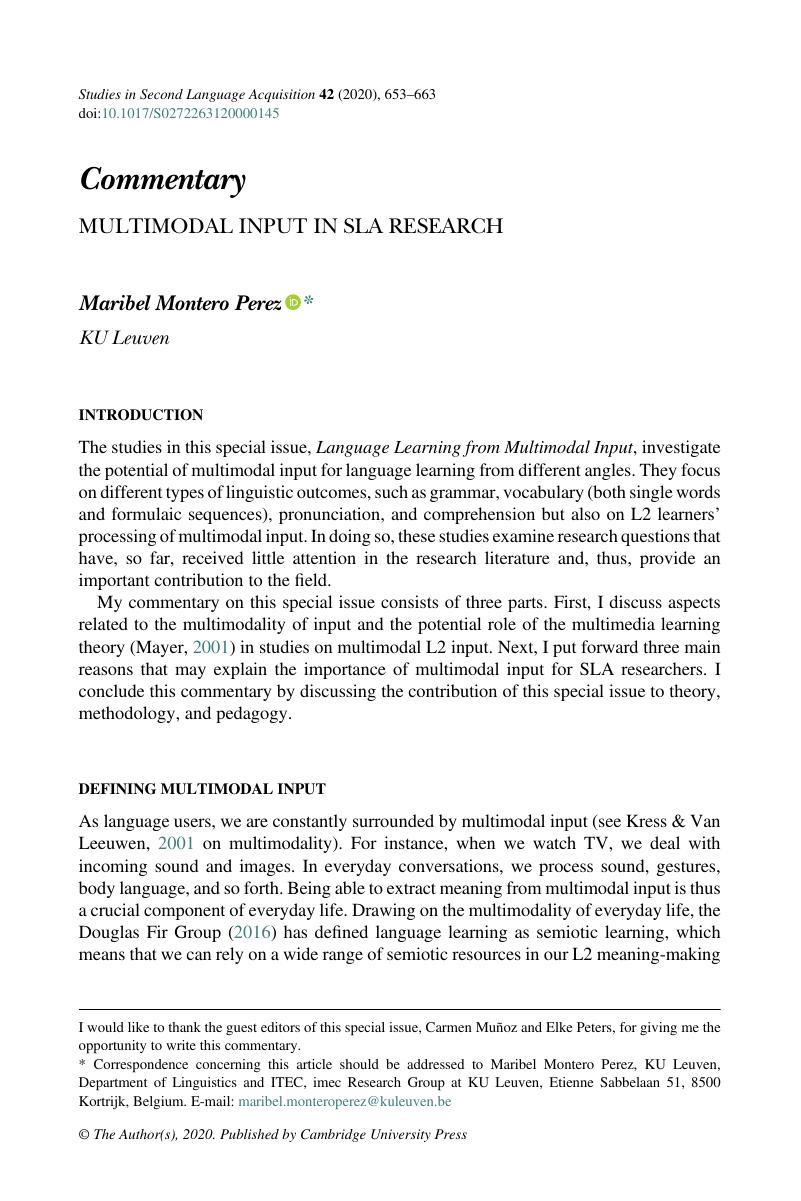Crossref Citations
This article has been cited by the following publications. This list is generated based on data provided by Crossref.
Dang, Thi Ngoc Yen
Lu, Cailing
and
Webb, Stuart
2022.
INCIDENTAL LEARNING OF SINGLE WORDS AND COLLOCATIONS THROUGH VIEWING AN ACADEMIC LECTURE.
Studies in Second Language Acquisition,
Vol. 44,
Issue. 3,
p.
708.
Pellicer-Sánchez, Ana
2022.
Multimodal reading and second language learning.
ITL - International Journal of Applied Linguistics,
Vol. 173,
Issue. 1,
p.
2.
Ellis, Nick C.
2022.
Second language learning of morphology.
Journal of the European Second Language Association,
Vol. 6,
Issue. 1,
p.
34.
Wu, Huizhen
Yu, Ping
Yang, Shenshen
and
Chen, Xuanyuan
2022.
Video Captioning Effects on EFL Listening Comprehension and Vocabulary Learning.
International Journal of Computer-Assisted Language Learning and Teaching,
Vol. 12,
Issue. 2,
p.
1.
Dang, Thi Ngoc Yen
Lu, Cailing
and
Webb, Stuart
2022.
Incidental Learning of Collocations in an Academic Lecture Through Different Input Modes.
Language Learning,
Vol. 72,
Issue. 3,
p.
728.
Lopez-Ozieblo, Renia
2023.
Theory and Practice from a Cognitive Perspective.
p.
113.
Wand, Ann
2023.
Segregation in Language Education.
p.
87.
Mai, Shijie
Ma, Xue’Er
and
Pei, Hong
2023.
A Comparative Study on the Effectiveness of Multimodal Input and Digital Multimodal Composing on Vocabulary Learning.
p.
244.
Vyatkina, Nina
2024.
Focus on meaning and form for advancing proficiency: The case of a multimedia online German course.
Die Unterrichtspraxis/Teaching German,
Vol. 57,
Issue. 2,
p.
230.
Gesa, Ferran
and
Miralpeix, Imma
2024.
Extensive viewing and L2 vocabulary learning.
ITL - International Journal of Applied Linguistics,
Vol. 175,
Issue. 2,
p.
187.
Vanbuel, Marieke
and
Deygers, Bart
2024.
Assessing Receptive Skills in an Adult L2 Learner Population with Diverse Educational Backgrounds.
Language Assessment Quarterly,
Vol. 21,
Issue. 4-5,
p.
379.
Kessler, Matt
2024.
Leveraging multimodal visualization reflections for L2 writing research.
Research Methods in Applied Linguistics,
Vol. 3,
Issue. 3,
p.
100126.
Bashir, Amina
Aziz, Aamir
Imran, Muhammad
and
Almusharraf, Norah
2025.
Effect of CALL-based multimodal pedagogy on learner motivation and willingness to communicate in English: A study from university students’ perspective.
Contemporary Educational Technology,
Vol. 17,
Issue. 2,
p.
ep568.
Sato, Masatoshi
Thorne, Steven L.
Michel, Marije
Alexopoulou, Theodora
and
Hellermann, John
2025.
Language, people, classrooms, world: Blending disparate theories for united language education practices.
The Modern Language Journal,
Vol. 109,
Issue. S1,
p.
15.
Chládková, Kateřina
Podlipský, Václav Jonáš
Jarůšková, Lucie
and
Šimáčková, Šárka
2025.
Tuning in to the prosody of a novel language is easier without orthography.
Bilingualism: Language and Cognition,
p.
1.
Wang, Chenghao
and
Li, Xueyun
2025.
Software Review.
International Journal of Computer-Assisted Language Learning and Teaching,
Vol. 15,
Issue. 1,
p.
1.




